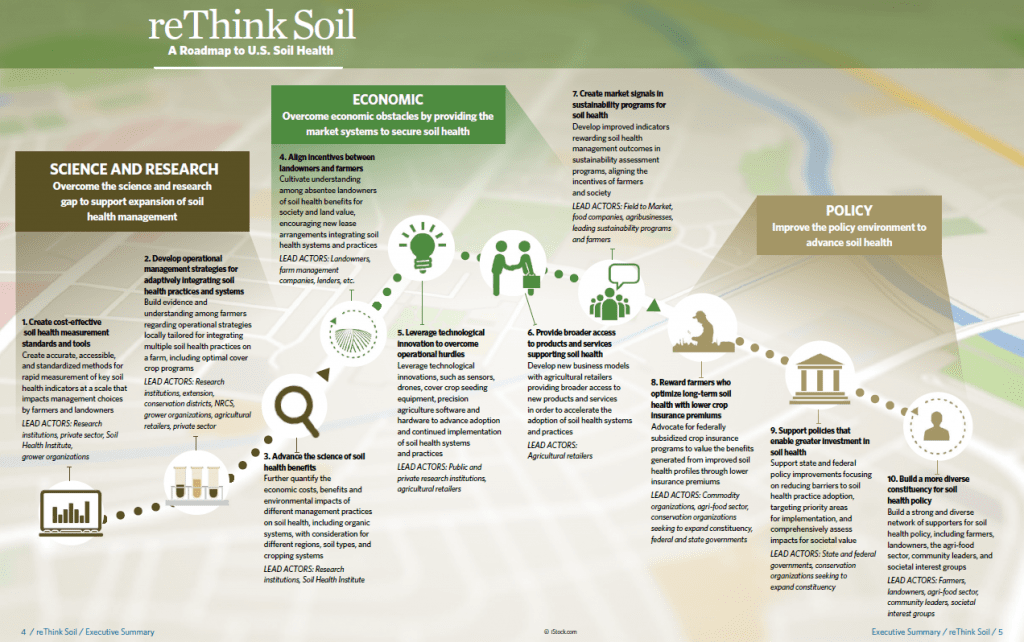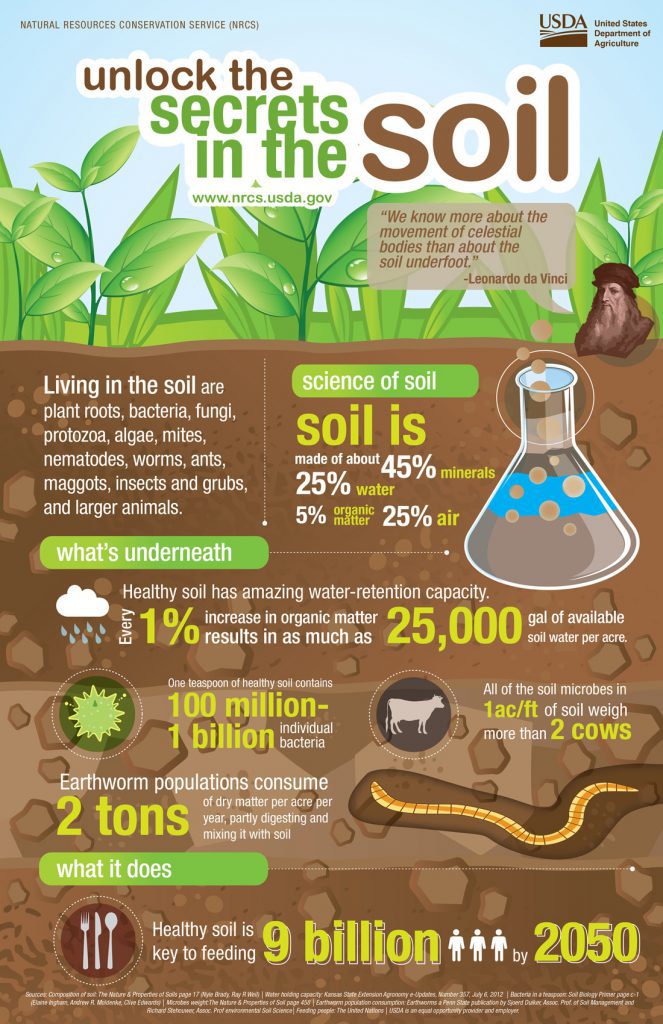“Healthy soils give us clean air and water, bountiful crops and forests, productive grazing lands, diverse wildlife, and beautiful landscapes.” USDA Natural Resources Conservation Service
Soil is comprised of minerals, organic matter, air and water, and therefore are complex and vital living components of an ecosystem. Soils sustain plant and animal life far beyond the observable surface by performing functions such as:
- Regulating water and solute flow
- Filtering and detoxifying matter
- Storing and cycling nutrients
- Providing support to structures
- Establishing resiliency in the face of flooding and drought
Soil quality is measured by amount of organic material, water holding capacity, depth of topsoil horizons, water infiltration rate, organic carbon content, nutrient content, bulk density, biological activity, and microbiological diversity.
The health of soil is directly related to the profits of famers. A 2017 study by the National Association of Conservation Districts found that using healthy soil practices such as cover crops and no tillage results in an economic return of over $100 per acre.
Soil Management Practice & Benefit
The NRCS has four soil health principles that can contribute to high functioning soils. These can be applied to farming practices, but also to how we care for our yards or grown our own gardens.
- Minimize soil disturbance
- Keep the soil covered
- Keep living roots in the soil
- Maximize diversity
These principals break down into specific soil management practices. Each have their own benefit.
| Practice | Decreased Pest Pressure | Improves Nutrient Use Efficiency | Improves Water Quality | Conserves Water | Improves Plant Health | Improves Water Efficiency to Crops | Saves non-Renewable Resources | Improves Air Quality | Increases Plant Pollination |
|---|---|---|---|---|---|---|---|---|---|
| Conservation Crop Rotation | X | X | X | X | X | X | X | X | X |
| Cover Crops | X | X | X | X | X | X | X | X | X |
| No Till | X | X | X | X | X | X | |||
| Mulch Tillage | X | X | X | X | X | X | |||
| Mulching | X | X | X | X | X | X | |||
| Nutrient Management | X | X | X | X | X | X | |||
| Pest Management | X | X | X | X | X | X | X | X |
Situation in Georgia
The complex make-up of soil means achieving soil health requires a delicate balance. Improper use, erosion, compaction, nutrient imbalance, pollution, acidification, water logging, loss of biodiversity, drought, and increasing salinity can cause unhealthy soils, leading to a reduced ability to support life and grow crops. The Nature Conservancy estimates that the societal and environmental costs of current inadequate soil practices exceed $85.1 billion annually.
Georgia soils have naturally low fertility and usually have low pH (acidic), due to years of cultivation. One of the greatest threats to Georgia specifically is the loss of topsoil and organic matter through erosion. Erosion occurs through rainfall and extreme precipitation events and is compounded by tillage practices. According to the EPA, the amount of precipitation in the Southeast has increased by 27% over the past 50 years, and is expected to continue to increase in frequency and severity in the future. Healthy soil practices are one way to combat Georgia’s soil erosion.
Soil Management as a Solution
The proper management and treatment of soils provides an opportunity to achieve meaningful conservation and economic benefits, increase health and productivity of farms and forests, reduce carbon dioxide emissions, and increase resiliency. Healthy Soil Practices include:
- Managed rotational grazing
- Using more perennial cropping and agroforestry
- Reducing tillage and soil compaction
- Diverse rotations
- Using organic materials and fertilizers
- Cover Cropping
- Farm-generated compost
Restoring soil health creates economic benefits for farmers and removes environmental and societal costs associated with current agricultural practices that will otherwise result in increasing costs. Specific and measurable benefits of healthy soil practices include:
- Increased soil carbon storage. The more soil is converted, the richer it will be in organic material and therefore in carbon. Soil organic matter has the potential to sequester 5-15% of greenhouse gases, or 25 million metric tons.
- Increased water retention (20-30% more capacity). Water retention is a factor of how porous the soil is; The more porous soil, the more capacity it has to retain water. This means less water is needed by farmers.
- Increased farm profitability resulting from higher yields and lower production costs, equaling to roughly $37 million for each 1% of cropland transformed, or $1.2 billion annually across the corn belt.
- Enhanced resistance to drought, flood, and heat. Soil aids in drought and flood risk management through water absorption. Up to 25,000 gallons per acre can be held in the top 6 inches of soil.
- Reducing 344 million pounds of nutrient loss to the environment. Healthy soil more efficiently stores and recycles carbon, water, nitrogen, and phosphorous.
- Reduced soil erosion (33% or 116 million metric tons).
- Reduced leaching and increased decomposition of pesticides
These environmental and social benefits are valued at over $7.4 billion annually. A coordinated and aligned policy approach to transforming the U.S. cropland management paradigm to focus on soil health as the leading indicator of economic and environmental outcomes is essential to reverse the negative trends on the economy and environmental quality and ensure these benefits.


